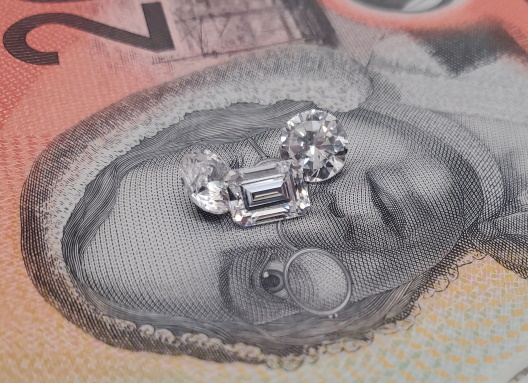When it comes to diamonds and crime, most people think of spectacular, and perhaps daring robberies, such as the 2013 Brussels Airport diamond heist or Argyle Diamond Mine heist. However, in Australia at least, crimes involving money laundering and loose polished diamonds are apparently non-existent, whereas crimes involving money laundering and banks or gold dealers make headline news.

A quick search of Google reveals numerous cases worldwide involving money laundering and diamonds. In fact, a 2006 article describes diamonds as “A Money Launderer’s Best Friend”.
The seemingly growing occurrence of money laundering crimes involving diamonds is hardly surprising given that in the past 20 years, polished diamonds have essentially become a commodity. Gone are the days of the diamond and jewellery trade basing the value of a gem on a “less than reliable” valuation or certification. Nowadays, one grading laboratory, the GIA, rules the roost, with most diamonds being laser inscribed and pricing available from a plethora of either wholesale or retail websites. This means that a 1ct round brilliant D/VVS2 with GIA certificate can be traded the world over at a fairly consistent price. This, combined with the fact that diamonds can be transported relatively cheaply and even be smuggled across borders without detection, certainly make them an attractive target for money launderers.
Whilst laundering money can involve “victimless” crimes, like tax evasion or wealth transfer, authorities’ main concerns have been focused on larger criminal gangs and terrorist funding. A study done by The Financial Action Task Force (FATF) and the Egmont Group describes the diamond trade as “vulnerable and risky” and notes that in the past few decades the diamond industry has become a lot more fragmented, moving from a monopoly controlled by De Beers to a much more de-centralised industry with a large number of smaller players and diamond manufacturing shifting from Belgium, Israel and the US to India and China.
As anyone involved in the diamond trade would know, there are certain regulations traders must comply with in order to prevent money laundering. In the US, the Patriot Act makes jewellers part of the financial system. This requires wholesalers and retailers to both properly identify their customers and to report transactions above $10,000 to the government. Similarly, in many countries around the world, opening and maintaining a bank account as a diamond dealer or jeweller is challenging to say the least. In fact, banks in Antwerp are now closing diamond traders’ accounts due to money laundering fears. This sort of behaviour by banks is not uncommon throughout the world. For example, opening a simple bank account as a diamond dealer in many countries is a long and drawn out process, and one that can take many months. Similarly, transferring money from one country to another for the purposes of diamond trading may draw the ire of a bank’s compliance department, with diamond traders forced to answer a myriad of questions in an attempt to prove they are not criminals.
However, back in Australia, there aren’t any specific laws to prevent money laundering in the diamond and jewellery industry.
The government agency responsible for regulation, would be AUSTRAC. However, at present, diamond dealers and jewellers are not included in those businesses providing a designated service that need to report certain activities to the government. In addition to this, in Australia, opening a bank account as a diamond dealer or jeweller is no different than any other business or person and can usually be done online with relative ease.
Over the years, there has been a lot of talk about regulating the diamond and jewellery industry in Australia. A 2002 paper admits diamonds can be used for money laundering and other crimes. Another paper in 2016 acknowledges the risk of money laundering, and apparently there was consultation with the industry in 2017. However, with 2023 nearly upon us, still nothing has been done.
Whether or not anything happens remains to be seen. My opinion is that there are definitely bad apples in the Australian diamond and jewellery industry, both inside the industry and its customers. Having said that, whether or not it is feasible remains to be seen. Problems that would occur would be:
- A fragmented industry, from chain stores, to those trading diamonds as a side hustle means that enforcement would be very difficult and probably a game of “whack-a-mole”.
- Compliance would be to burdensome to some. Whilst a $10,000 transaction may seem large, in the diamond industry, it is a fairly day-to-day occurrence, and some, if not most businesses in the industry would find compliance too burdensome.
- Banks and authorities probably don’t have the expertise. In order to properly enforce such laws, both banks and governments would need the expertise both in diamonds, but also other high value goods such as fine art, antiques and collectibles.
Given these hurdles, and the fact that the topic hasn’t rated a mention since 2017, it would seem the diamond and jewellery industry will remain unregulated in a financial sense, and diamonds may well continue to be “A Money Launderer’s Best Friend”.